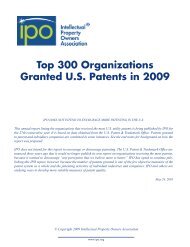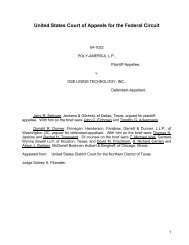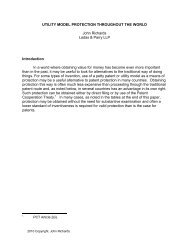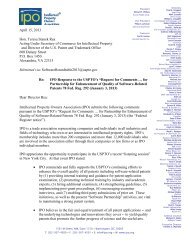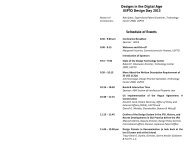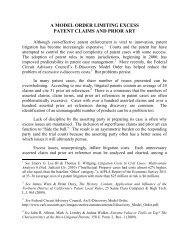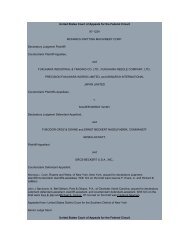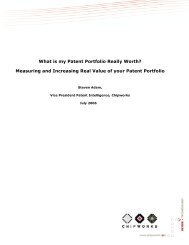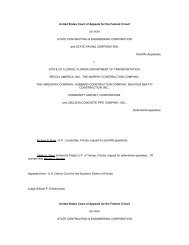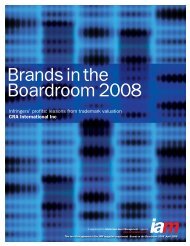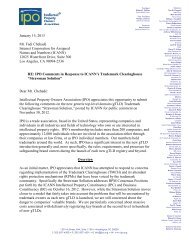Ruiz v. A.B. Chance Co.
Ruiz v. A.B. Chance Co.
Ruiz v. A.B. Chance Co.
You also want an ePaper? Increase the reach of your titles
YUMPU automatically turns print PDFs into web optimized ePapers that Google loves.
particularly would lead one of ordinary skill in the art to combine screw anchors and metal brackets; 2) the<br />
level of ordinary skill in the art; and 3) whether, and to what effect, evidence of secondary considerations,<br />
such as commercial success, long-felt but unresolved need, failure of others, copying, and unexpected<br />
results, is probative in the obviousness analysis.<br />
We affirm the district court’s finding of infringement, and its refusal to award attorney fees and costs. We<br />
also affirm the district court’s grant of summary judgment on the non-patent claims.<br />
Background<br />
A. The <strong>Chance</strong> Patents<br />
Since the 1970s, <strong>Chance</strong> has manufactured and sold screw anchors, also known as helical anchors, for<br />
stabilizing and supporting electrical transmission over tower legs. A screw anchor consists of "an elongated<br />
shaft presenting an earth-penetrating tip and a transversely extending load-bearing member." ’368 patent,<br />
col. 2, ll. 32-35. In late 1988, <strong>Chance</strong> began using screw anchors with metal brackets to stabilize residential<br />
and commercial structures. The craft of stabilizing a sinking structure is known as "underpinning." In March<br />
1989, <strong>Chance</strong> engineers demonstrated a prototype of its invention to Richard Fuller and Stan Rupiper, who<br />
used a method of underpinning employing screw anchors with concrete haunches. As the district court<br />
noted, "[a]t that time, neither Fuller nor Rupiper made any indication that they felt they had already designed<br />
a bracket or had already been using a bracket or a support of the same type."<br />
In 1992, the Patent and Trademark Office ("PTO") issued <strong>Chance</strong> the ’368 and ’107 patents, entitled<br />
"Method of Underpinning Existing Structures," covering its methods for underpinning residential and<br />
commercial foundations using screw anchors and metal brackets. The ’107 patent is a continuation of the<br />
’368 patent, which in turn is a continuation-in-part of patent application serial number 07/464,937 (issuing as<br />
U.S. Patent No. 5,011,336 ("the ’336 patent")). The <strong>Chance</strong> patents are "concerned with an improved<br />
anchor apparatus designed to support and resist settling of structural foundations" particularly for "existing<br />
building structures having a predetermined weight and which may or has experienced settlement or<br />
movement." ’368 patent, col. 1, ll. 13-20. In the method claimed in the ’368 patent, the metal bracket<br />
connects the screw anchor to the foundation and transfers the dead weight and live load of the foundation to<br />
each screw anchor. See id., col. 2, ll. 20-26. Users of the method place the screw anchor adjacent to the<br />
footing, and then rotate and screw the anchor "below the footing until the upper end of the shaft is adjacent<br />
the footing and a predetermined resistance to rotation of the anchor has been achieved." Id., col. 2, ll. 31-39.<br />
"Upon release of rotational torque on the anchor shaft so that the anchor may return to its unstressed state,<br />
the anchor shaft and foundation and/or footing are connected via a [metal] bracket assembly to establish the<br />
desired load-bearing relationship." Id., col. 2, ll. 45-50.<br />
B. The Prior Art<br />
1. The Gregory Patents<br />
U.S. Patent Nos. 4,911,580 ("the ’580 patent") and 4,765,777 ("the ’777 patent"), issued to Gregory,<br />
disclose an apparatus and method for raising and supporting a structure using push piers and metal<br />
brackets. In the Gregory method, the user attaches a metal bracket to the foundation and drives the push<br />
piers through the bracket and into the ground until encountering resistance from soil friction or impinging<br />
upon bedrock. ’580 patent, col. 4, ll. 21-26. <strong>Co</strong>ntinued force lifts the foundation, and transfers the weight of<br />
the structure to the pier. Further movement of the foundation may take place following transfer of the load,<br />
particularly if the pier is held in place by soil or friction.<br />
2. The Fuller and Rupiper Method<br />
The Fuller and Rupiper method uses screw anchors with concrete haunches as an underpinning solution. In<br />
this method, popular in settings having high seismic activity such as California, the user excavates the earth<br />
around and beneath the foundation to install a screw anchor and to place steel reinforcing rods in the<br />
excavation. The contractor then pours concrete into the excavation and allows the concrete to dry before<br />
backfilling the excavation. In the concrete haunch method, the weight of the structure is not transferred to<br />
the screw anchor until there is further downward settlement of the foundation onto the hardened concrete.<br />
This method must also be performed in a specific sequence, as the screw anchor must be installed before<br />
the concrete hardens, and the resulting connection is formed.<br />
C. The Distributorship Agreement between <strong>Chance</strong> and Fasteel



